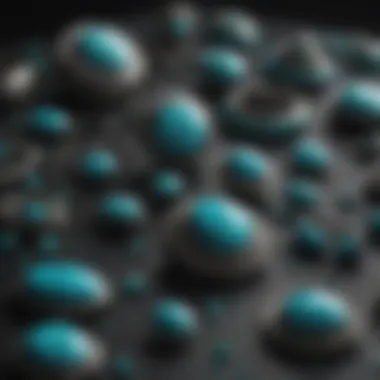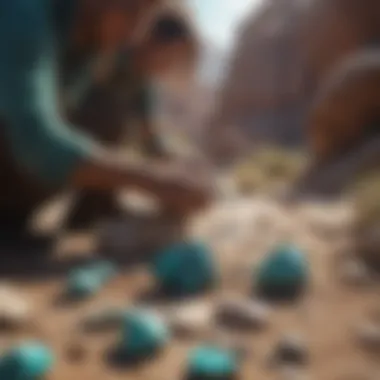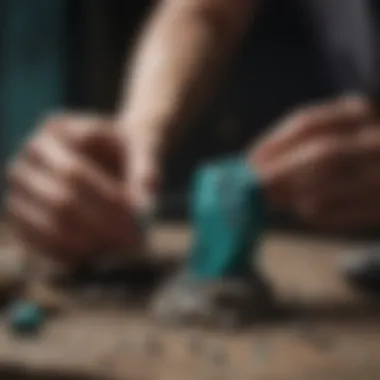Exploring Turquoise: A Collector's Insightful Guide


Intro
Turquoise, a gem admired for its vibrant blue hues, has a rich history and cultural significance across the world. This article aims to explore the various facets of turquoise pieces, offering insight into their geological formation, historical importance, and the art of collecting them. Understanding these elements is vital for collectors and enthusiasts alike.
Turquoise has been cherished for millennia, with artifacts dating back to ancient civilizations. Its unique aesthetic and symbolic value have made it a prized possession in many cultures. As we embark on this journey, we will dissect its appeal, discuss techniques for identification, and provide essential tips for preservation.
Featured Collectible of the Month
In this section, we spotlight one of the most sought-after turquoise collectibles within the community.
Overview
The featured collectible for this month is a beautifully crafted turquoise necklace from the Navajo tribe. This piece exemplifies exceptional craftsmanship and attention to detail, showcasing a combination of natural turquoise stones set in sterling silver.
Historical Significance
The significance of turquoise goes beyond its physical attributes. Among Native American cultures, including the Navajo and Pueblo tribes, turquoise is revered as a symbol of protection and healing. Historically, turquoise jewelry was often used in rituals and ceremonies, with the belief that it held the power to connect the spiritual and physical realms. Collecting pieces like this necklace not only allows one to appreciate the artistry but also to honor the rich traditions associated with the gemstone.
Identification Techniques
Identifying authentic turquoise can be challenging. There are several techniques available that can aid collectors in distinguishing genuine pieces from imitations.
Visual Characteristics
When examining a turquoise piece, consider the following visual characteristics:
- Color Variations: Natural turquoise displays a range of hues, primarily blue and green, often with matrix patterns, which are unique lines or speckles within the stone.
- Hardness: Turquoise is relatively soft, scoring between 5 and 6 on the Mohs scale, making it easy to scratch if subjected to rough handling.
- Finish Quality: Authentic turquoise should have a smooth polish without visible signs of artificial enhancement.
Resources for Identification
For further insights, collectors can refer to several trustworthy resources. Websites like Wikipedia and Britannica provide authoritative information on turquoise. Engaging in forums on platforms such as Reddit may also be beneficial. Additionally, social media groups on Facebook can serve as a support network for hive-minded individuals to share knowledge and experiences regarding turquoise identification.
"Knowledge is power when it comes to collecting. Educate yourself not just on the pieces, but on their stories."
In the following sections, we will delve deeper into the preservation methods and explore current market trends shaping the value of turquoise pieces.
Prelude to Turquoise
The exploration of turquoise serves as a gateway to understanding both its natural formation and cultural significance. Being valued for its captivating hue, turquoise has also played an integral role in history across various civilizations. This section serves as a foundation for the entire article, outlining key elements that will help readers appreciate the allure of these stones.
Definition and Overview
Turquoise is a blue to green mineral that is hydrated copper and aluminum phosphate. The color of the stone varies greatly, often depending on the presence of various elements. For example, iron can introduce green hues while copper intensifies the blue. It has been utilized in jewelry and ornamentation for thousands of years. The stone's captivating appearance does not only draw aesthetic appreciation but also has links to deeper cultural meanings.
Turquoise is known not just for its beauty but also for its properties in various traditional belief systems. Throughout history, people have associated the stone with protection and healing. Many ancient cultures, from the Native Americans to ancient Egyptians, treasured turquoise for its perceived spiritual properties.
Understanding the definition and nature of turquoise can enhance one's appreciation for both collecting and displaying these pieces.
A Brief History
The history of turquoise is extensive and varied, reflecting its geographic and cultural breadth. Turquoise mining dates back to ancient civilizations. The earliest known use of turquoise can be traced to Iran, where it has been mined for over 5,000 years. It was often used in the decoration of royal tombs, signifying its high value.
In pre-Columbian America, turquoise was extensively used by Native Americans, especially in the Southwest. Tribes such as the Navajo and Pueblo incorporated turquoise into their art and jewelry, viewing it as a sacred stone. It played a significant role in their cultural rituals and traditions.
"Turquoise has a rich history, with its significance transcending geography and culture. Its values are deeply embedded in the traditions of many societies."


As we delve deeper into the subject, it becomes evident that turquoise is not merely a decorative item, but a piece woven into the fabric of history. Its varied uses across different eras provide insight into the cultures that cherished this beautiful stone.
Geology of Turquoise
Understanding the geology of turquoise is crucial for recognizing its value, origin, and uniqueness. This section will explore the formation processes of turquoise and its geographic distribution, providing essential knowledge for collectors and enthusiasts alike. Knowledge of geology not only enhances appreciation for turquoise pieces but also guides collectors in making informed decisions when acquiring them.
Formation Processes
Turquoise is a hydrated phosphate of copper and aluminum, formed under specific geological conditions. Its creation begins in arid, semi-arid areas where copper-mineralized rocks undergo a complex alteration process. Silica-laden waters seep into the fractures of these rocks, transforming and depositing minerals over time. The result is a beautiful gemstone often characterized by its blue to green hues.
The typical formation involves several key steps:
- Oxidation of Copper: Copper is released from the host rock and oxidizes in the presence of oxygen, creating sulfate and phosphate compounds.
- Leaching: Water infiltrates through the rock layers, transporting the dissolved minerals, which then accumulate in cavities or fractures.
- Crystallization: As the environment changes, evaporation may occur, leading to the precipitation of turquoise crystals.
- Hydration: The presence of water during the crystallization process is vital, giving turquoise its characteristic structure and color.
These processes can take thousands of years, producing formations of varying quality and appearance. Natural turquoise is often favored for its uniqueness, while manufactured alternatives may lack similar geological narrative.
Geographic Distribution
Turquoise has been found in multiple locations across the globe, each site contributing distinct characteristics based on the local geological setting. Significant sources include:
- United States: The Southwest region, particularly Arizona and New Mexico, stands out with renowned turquoise mines like the Sleeping Beauty mine, known for its vibrant blue stones.
- Iran: Historically significant, Iranian turquoise, often called "Persian turquoise", boasts rich green color and is considered of high quality due to its unique mineral composition.
- Egypt: The Sinai Peninsula is one of the ancient sources of turquoise, with its historical ties to the Pharaohs who utilized the stone in jewelry and crafts.
- China: The country has emerged as a significant player in turquoise production, offering both natural stones and treated alternatives.
Collectors should understand these geographic variations as they contribute to the stone’s value and uniqueness. The context of where a turquoise piece originated can enhance its allure and significance in the realm of gemstone collecting.
Turquoise in Culture
Turquoise has held a significant role in various cultures throughout history. Its unique color and inherent qualities have made it a cherished material in many societies. This section will explore the symbols, meanings, and applications of turquoise in art and craftsmanship, showcasing its cultural relevance.
Symbols and Meanings
Turquoise is often associated with a range of symbolic meanings across different cultures. It is viewed as a protective stone, believed to bring good fortune and ward off negative energies. Many Indigenous peoples, including the Native Americans, regard turquoise as sacred. It embodies connection to the Earth and sky, symbolizing balance and serenity.
Furthermore, turquoise is also perceived as an emblem of health, providing vitality and strength. In many cultures, this stone is used in spiritual practices, acting as a conduit for healing and communication with higher realms. Notably, some tribes use turquoise in rituals to enhance their connection with nature. It is often fashioned into amulets or incorporated into ceremonial artifacts.
"Turquoise is more than just a stone; it is a bridge between the physical and the spiritual."
The meanings associated with turquoise can vary. For instance, in Middle Eastern cultures, it is often seen as a representation of hope and protection. It is common in jewelry and architecture, signifying wealth and status. These diverse interpretations highlight the universal appreciation of turquoise's beauty and mystical qualities.
Turquoise in Art and Craft
The artistic application of turquoise is vast and varied. For centuries, artisans have utilized this stone in jewelry, pottery, and textiles. The vibrant hues not only add aesthetic appeal but also convey cultural narratives. In Native American art, turquoise is especially prominent. It is often combined with silver to create stunning jewelry pieces, each with its own story.
Moreover, turquoise has been employed in ancient mosaics, where it was used alongside other materials to create intricate designs. The craft of inlay, where turquoise is set into another material such as wood or metal, remains a treasured skill in many cultures. Such pieces are not merely decorative; they often hold cultural significance.
In contemporary art, artists continue to embrace turquoise, integrating it into modern designs that reflect traditional meanings.
Key considerations for artisans working with turquoise include:
- Color Retention: Artists must ensure that the natural colors of turquoise are maintained during processing.
- Sourcing Authentic Material: Genuine turquoise is becoming rarer, making authenticity crucial for both craft and value.
- Cultural Sensitivity: Understanding the meaning and respect for cultural traditions associated with turquoise is vital in crafting pieces that are truly representative.
Types of Turquoise Pieces
Understanding the different types of turquoise pieces is essential for collectors and enthusiasts. This knowledge not only helps in making informed purchasing decisions but also adds depth to one's appreciation of these captivating stones. Turquoise, with its distinctive hues and patterns, varies greatly in quality, source, and treatment. Knowing what to look for enhances a collector’s journey, making it more rewarding.
Natural vs. Treated Turquoise
Natural turquoise is a coveted find due to its organic origin. It forms over thousands of years, often in arid climates. Each stone carries unique characteristics, reflecting its geological history. Collectors seek natural stones for their rarity and authenticity. They often display matrix patterns that add to their appeal.


Treated turquoise, on the other hand, has been altered to improve its appearance. Common treatments include dyeing and stabilization, which enhance color and durability. While treated stones can be visually striking, they lack the intrinsic value of natural turquoise. Understanding the difference is crucial when assessing price and quality.
- Natural Turquoise:
- Treated Turquoise:
- Authentic geological formation
- Unique patterns and colors
- Higher value in the collectors’ market
- Enhanced appearance through treatments
- Potentially lower resale value
- A wide variety of colors not typically seen in natural stones
It is often beneficial to ask for certification when purchasing turquoise, as this can confirm whether the piece is natural or treated.
Carved and Inlaid Pieces
Carved and inlaid turquoise pieces represent an artistic intersection of culture and craftsmanship. Carved turquoise often showcases the artisan’s skill and can include intricate designs. These pieces, whether jewelry or decorative objects, are sought after for their aesthetic and cultural value. The carving process enhances the stone's natural beauty while preserving its inherent qualities. Carved turquoise can tell stories through its design, often reflecting cultural symbols or themes.
Inlaid turquoise involves placing small pieces of turquoise within a base material. This technique results in striking designs that bring out the color variations within the turquoise itself. Inlaid pieces can be found in items like jewelry, furniture, and home decor. They are often used to create patterns and images, blending turquoise with materials such as silver, gold, or wood.
- Benefits of Carved Pieces:
- Benefits of Inlaid Pieces:
- Unique artistry
- Enhanced value through craftsmanship
- Typically one-of-a-kind items
- Eye-catching designs
- Opportunities for creative expression
- Can complement various interior design styles
Overall, both carved and inlaid turquoise pieces offer various avenues for collectors and can be a focal point in any collection. The choices made in selecting these types of turquoise pieces can significantly impact both personal enjoyment and potential value.
Collecting Turquoise
Collecting turquoise is a fascinating and rewarding pursuit. This activity goes beyond mere ownership; it involves appreciating a gemstone with rich geological and cultural dimensions. The nuances of collecting turquoise can enrich one’s appreciation of this unique stone. For newcomers and seasoned collectors alike, understanding the key elements of turquoise collection is crucial.
Starting a collection allows one to engage directly with the stories behind each piece. A collector can explore different varieties, learning to distinguish their features. Additionally, understanding the market dynamics helps in making informed purchases.
Starting a Collection
Beginning a turquoise collection does not require vast resources or expertise. It is about exploring and finding joy in the search for beautiful pieces. Here are some steps to consider:
- Research: Start with understanding the geology and historical context of turquoise. Books, websites, and forums can provide valuable insights. Engaging with communities on platforms like Reddit can open doors to networking.
- Budgeting: Define a budget for your collection. This ensures you remain focused and prevents impulsive purchases.
- Identifying Preferences: Determine what aspects of turquoise interest you most. Are you drawn to natural stones, unique cuts, or perhaps, cultural carvings? This will guide your purchasing decisions.
- Attend Shows: Visiting gem and mineral shows can provide hands-on experience. You can meet vendors, negotiate prices, and establish relationships in the industry.
By following these steps, collectors can build a meaningful and diverse collection over time.
Identifying Authentic Pieces
As a collector, the ability to identify authentic turquoise is paramount. This knowledge protects against the rising tide of forgeries and treated stones in the market. Here are several key tips:
- Know the Color: Authentic turquoise has a distinctive color range, from sky blue to greenish tones. Be wary of overly bright or uniform colors.
- Assess the Texture: Genuine turquoise feels smooth yet slightly porous. A polished finish can disguise flaws, but under magnification, natural matrix patterns become visible.
- Calculate Weight: Real turquoise is denser than many imitations. If a piece feels unexpectedly light, it may be a fake.
- Request Certified Documentation: When purchasing expensive pieces, ask for certification. Reputable sellers should provide this to assure authenticity.
"Familiarity with these signs will empower collectors to make informed decisions."
Close examination and knowledge can greatly reduce the risk of acquiring fakes.
Common Forgery Signs
Detecting counterfeit turquoise is essential for any collector. Knowing what to look for can save both money and disappointment. Here are common signs of forgery:
- Synthetic Variants: Some turquoise is manufactured in labs. These pieces may appear unnaturally vibrant and glossy.
- Color Treatment: Look for stones dyed to enhance color. Color may be too uniform or leach into the surrounding matrix.
- Inconsistent Patterns: Authentic turquoise showcases unique patterns. If a piece has predictable or poorly defined designs, it likely isn’t genuine.
- Bubbles or Inclusions: In synthetic turquoise, you may find bubbles or other man-made inconsistencies. Authentic stones feature natural inclusions that add character.
Understanding these signs is vital for building a credible collection. With careful observation and research, collectors can confidently navigate the turquoise market.


Preservation and Care
Preserving turquoise pieces is essential to maintain their beauty and value. Turquoise is a relatively soft gemstone, making it susceptible to scratches, discoloration, and damage if not handled properly. Understanding the importance of preservation can help collectors enjoy their pieces for many years while safeguarding their investments. In this section, we will discuss effective cleaning techniques and optimal storage conditions to ensure the longevity of turquoise.
Cleaning Techniques
Cleaning turquoise requires a delicate touch. Here are some methods to properly clean your turquoise pieces:
- Use Soft Cloth: For day-to-day maintenance, use a clean, soft cloth to wipe the surface. This will remove dust and dirt without scratching.
- Mild Soap Solution: If the piece is heavily soiled, mix a small amount of mild soap with lukewarm water. Dampen the cloth with this solution and gently clean the turquoise. Avoid soaking.
- Avoid Chemical Cleaners: Strong chemicals can damage the stone. Always use natural cleaning solutions to maintain the integrity of the turquoise.
- Rinse Carefully: If using soap, it is crucial to rinse the piece using a damp cloth with clean water. Ensure that no residual soap remains, as it can affect the color of the stone.
Following these cleaning methods will help preserve the vibrancy and shine of turquoise while ensuring their longevity.
Storage Conditions
Proper storage of turquoise pieces is equally important. Here are some best practices for storing your prized items:
- Avoid Direct Sunlight: Store your turquoise in a cool, dark place away from sunlight. Prolonged exposure may fade the color.
- Use Individual Pouches: To prevent scratches, consider using soft fabric pouches for each piece. This will also protect them from potential impact with other items.
- Keep Away from Hard Surfaces: When storing turquoise, ensure it is not placed on hard surfaces without protective coverings. This reduces the risk of scratches.
- Ideal Temperature and Humidity: Favor a stable environment. High humidity can lead to mineral degradation, while extreme dryness can cause the stone to crack.
Understanding these considerations for cleaning and storing turquoise will help maintain its condition. Proper care ensures that your collection remains beautiful and valuable over time, ultimately enriching your experience as a collector.
Market Trends and Valuation
The market for turquoise pieces is dynamic and intricate. Understanding the market trends and valuation of turquoise is crucial for collectors and enthusiasts. This awareness helps in making informed decisions regarding buying and selling. Factors influencing these trends include changes in consumer preferences, rarity of particular varieties, and shifts in sourcing methods.
Factors Influencing Value
The value of turquoise pieces can vary significantly based on several factors. Here are some key elements:
- Quality: Higher quality stones with vibrant color and less matrix will command higher prices. Grades of turquoise range from high-grade natural stones to lower-quality treated ones.
- Origin: Turquoise from certain locations, such as Persian or Sleeping Beauty turquoise, tends to be more valuable due to their reputation for superior quality.
- Market Demand: Collectors often drive demand for specific types. As trends in jewelry and decorative arts fluctuate, so do prices.
- Artistry: The craftsmanship involved in creating turquoise pieces—such as jewelry or carved items—can greatly influence value. Notably crafted pieces by recognized artisans may hold more worth.
“The value of turquoise is not only dictated by its aesthetic appeal but also by its historical context and market demand.”
Current Market Dynamics
Currently, the turquoise market is experiencing unique dynamics. Increased interest in authentic, natural materials promotes higher demand. Collectors are increasingly seeking ethically sourced turquoise, following a broader trend towards sustainability.
In the retail market, online platforms have expanded access to turquoise pieces, both for collectors and casual buyers. This accessibility can lead to fluctuating prices in response to supply and demand in various marketplaces.
There is also a growing concern regarding forgeries. In response, collectors are prioritizing verification methods, contributing to a more informed buying culture. As the market evolves, awareness of these aspects will likely enhance overall collector engagement.
Understanding these market trends and valuation factors can provide significant advantages. It allows collectors to navigate the nuances of this captivating domain more effectively.
Culmination
The conclusion serves as a pivotal section of this article, encasing the insights gathered throughout our exploration of turquoise pieces. Understanding the depth of this subject is crucial not only for enthusiasts but also for serious collectors. It encapsulates the journey through geology, culture, and market trends while highlighting significant factors that influence value.
The main benefit of a robust conclusion lies in its ability to synthesize core points. By summarizing key takeaways, it fosters better retention of information and enhances the reader's capacity to apply this knowledge in practical settings. Additionally, recognizing the future implications within the realm of turquoise collecting establishes a sense of direction. This foresight can help collectors anticipate market changes and navigate their collecting strategies more effectively.
Summary of Key Points
- Geological Formation: Understanding the formation processes and geographic distribution of turquoise enriches appreciation for this unique mineral.
- Cultural Significance: The symbolism and artistic value of turquoise underscore its importance across various cultures, making it a fascinating subject of study.
- Collecting Techniques: Commencing a turquoise collection requires knowledge of authentic pieces, along with recognizing signs of forgery.
- Preservation Measures: Proper cleaning and storage techniques are essential for maintaining the integrity of turquoise items.
- Market Dynamics: Current market trends and the factors influencing value are critical aspects for collectors to monitor.
Future of Turquoise Collecting
The landscape of turquoise collecting is in constant flux. Environmental factors, such as mining regulations and sustainability issues, play a significant role in availability. There is also a growing trend in the market that highlights the importance of ethics in sourcing gemstones. Collectors are increasingly aware of the environmental and social implications of their purchases.
Moreover, technological advancements in identification processes are set to enhance the credibility of the market. Innovations offer improved methods for assessing authenticity and quality. This progression will likely attract a broader audience to turquoise collecting, enriching the community.
For collectors, the future also implies adaptation. Staying informed about market trends, ethical sourcing, and preservation techniques will be vital for those wishing to cultivate a meaningful collection.
"Turquoise is not only a stone; it is a reflection of culture and commitment to responsible collecting practices."
In summary, the world of turquoise pieces is intricate, with many layers waiting to be discovered. Approaching this field with knowledge, care, and foresight will undoubtedly yield rewarding experiences for collectors for years to come.



